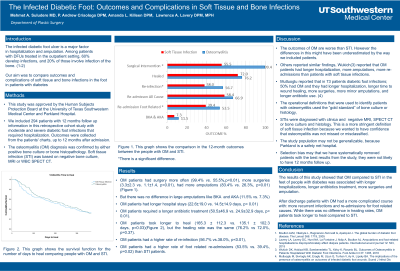Clinical Research
(DLS-037) The Infected Diabetic Foot: Outcomes and Complications in Soft Tissue and Bone Infections
Friday, April 28, 2023
7:15 PM - 8:30 PM East Coast USA Time

Peter Crisologo, DPM; Lawrence Lavery, DPM, MPH – Professor
Introduction: Our aim was to compare outcomes and complications of soft tissue and bone infections in the foot in patients with diabetes
Methods: Two hundred and ninety-four patients were included in this retrospective cohort study of moderate and severe diabetic foot infections that required hospitalization. The severity of the infection was based on the International Working Group on the Diabetic Foot infection classification. The osteomyelitis (OM) diagnosis was confirmed by bone culture or histopathology. Soft tissue infection was based on negative bone culture, MRI or WBC SPECT CT. We collected the information on the outcomes from the patients' charts, up to 12 months after admission. We used χ2 to compare the differences in dichotomous variables. We used an alpha less than 0.05 as the cutoff for significance.
Results: Clinical outcomes were worse in patients with OM. They required surgery more often (99.4% vs. 55.5%, p<0.01), more surgeries (3.3±2.3 vs. 1.1±1.4, p< 0.01), and more amputations (83.4% vs. 26.3%, p<0.01) than STI patients. OM patients had longer hospital stays (22.6±19.0 vs. 14.5±14.9 days, p< 0.01), and required a longer antibiotic treatment (50.5±46.9 vs. 24.9±32.9 days, p< 0.01). During the one year follow up, OM patients took longer to heal (165.3±112.3 vs. 135.1±102.3 days, p=0.03), had a higher rate of re-infection (56.7% vs. 38.0%, p<0.01), and had a higher rate of foot related re-admissions (53.5% vs. 39.4%, p=0.02) than STI patients.
Discussion: OM patients had more surgery, amputations, and longer antibiotic treatment as well as more re-infections and foot related re-admissions compared to patients with STI.
Methods: Two hundred and ninety-four patients were included in this retrospective cohort study of moderate and severe diabetic foot infections that required hospitalization. The severity of the infection was based on the International Working Group on the Diabetic Foot infection classification. The osteomyelitis (OM) diagnosis was confirmed by bone culture or histopathology. Soft tissue infection was based on negative bone culture, MRI or WBC SPECT CT. We collected the information on the outcomes from the patients' charts, up to 12 months after admission. We used χ2 to compare the differences in dichotomous variables. We used an alpha less than 0.05 as the cutoff for significance.
Results: Clinical outcomes were worse in patients with OM. They required surgery more often (99.4% vs. 55.5%, p<0.01), more surgeries (3.3±2.3 vs. 1.1±1.4, p< 0.01), and more amputations (83.4% vs. 26.3%, p<0.01) than STI patients. OM patients had longer hospital stays (22.6±19.0 vs. 14.5±14.9 days, p< 0.01), and required a longer antibiotic treatment (50.5±46.9 vs. 24.9±32.9 days, p< 0.01). During the one year follow up, OM patients took longer to heal (165.3±112.3 vs. 135.1±102.3 days, p=0.03), had a higher rate of re-infection (56.7% vs. 38.0%, p<0.01), and had a higher rate of foot related re-admissions (53.5% vs. 39.4%, p=0.02) than STI patients.
Discussion: OM patients had more surgery, amputations, and longer antibiotic treatment as well as more re-infections and foot related re-admissions compared to patients with STI.

.png)
